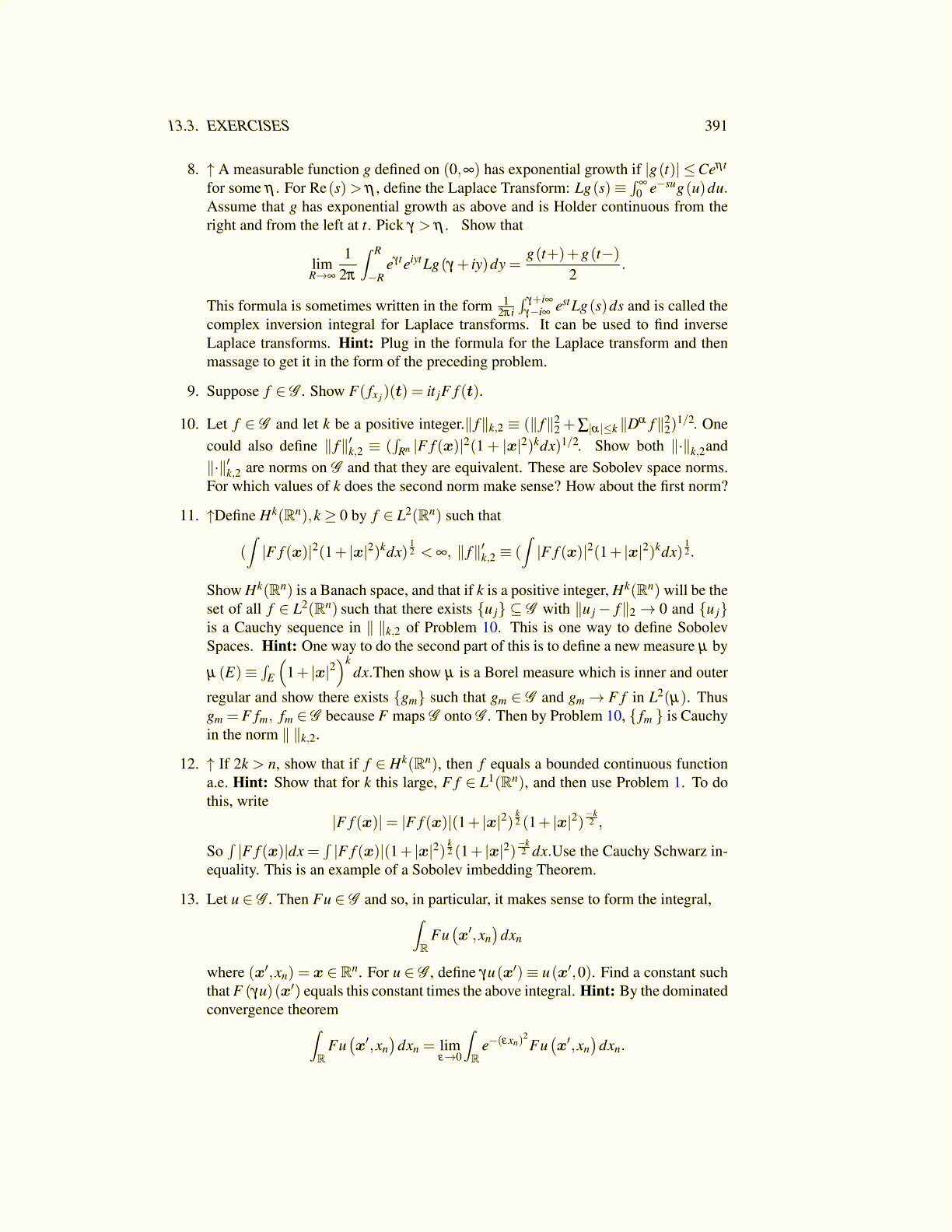
13.3. EXERCISES 391
8. ↑ A measurable function g defined on (0,∞) has exponential growth if |g(t)| ≤Ceηt
for some η . For Re(s)> η , define the Laplace Transform: Lg(s)≡∫
∞
0 e−sug(u)du.Assume that g has exponential growth as above and is Holder continuous from theright and from the left at t. Pick γ > η . Show that
limR→∞
12π
∫ R
−ReγteiytLg(γ + iy)dy =
g(t+)+g(t−)2
.
This formula is sometimes written in the form 12πi∫ γ+i∞
γ−i∞ estLg(s)ds and is called thecomplex inversion integral for Laplace transforms. It can be used to find inverseLaplace transforms. Hint: Plug in the formula for the Laplace transform and thenmassage to get it in the form of the preceding problem.
9. Suppose f ∈ G . Show F( fx j)(t) = it jF f (t).
10. Let f ∈ G and let k be a positive integer.∥ f∥k,2 ≡ (∥ f∥22 +∑|α|≤k ∥Dα f∥2
2)1/2. One
could also define ∥ f∥′k,2 ≡ (∫
Rn |F f (x)|2(1 + |x|2)kdx)1/2. Show both ∥·∥k,2and∥·∥′k,2 are norms on G and that they are equivalent. These are Sobolev space norms.For which values of k does the second norm make sense? How about the first norm?
11. ↑Define Hk(Rn),k ≥ 0 by f ∈ L2(Rn) such that
(∫|F f (x)|2(1+ |x|2)kdx)
12 < ∞, ∥ f∥′k,2 ≡ (
∫|F f (x)|2(1+ |x|2)kdx)
12.
Show Hk(Rn) is a Banach space, and that if k is a positive integer, Hk(Rn) will be theset of all f ∈ L2(Rn) such that there exists {u j} ⊆ G with ∥u j− f∥2 → 0 and {u j}is a Cauchy sequence in ∥ ∥k,2 of Problem 10. This is one way to define SobolevSpaces. Hint: One way to do the second part of this is to define a new measure µ by
µ (E)≡∫
E
(1+ |x|2
)kdx.Then show µ is a Borel measure which is inner and outer
regular and show there exists {gm} such that gm ∈ G and gm→ F f in L2(µ). Thusgm = F fm, fm ∈ G because F maps G onto G . Then by Problem 10, { fm } is Cauchyin the norm ∥ ∥k,2.
12. ↑ If 2k > n, show that if f ∈ Hk(Rn), then f equals a bounded continuous functiona.e. Hint: Show that for k this large, F f ∈ L1(Rn), and then use Problem 1. To dothis, write
|F f (x)|= |F f (x)|(1+ |x|2)k2 (1+ |x|2)
−k2 ,
So∫|F f (x)|dx =
∫|F f (x)|(1+ |x|2) k
2 (1+ |x|2)−k2 dx.Use the Cauchy Schwarz in-
equality. This is an example of a Sobolev imbedding Theorem.
13. Let u ∈ G . Then Fu ∈ G and so, in particular, it makes sense to form the integral,∫R
Fu(x′,xn
)dxn
where (x′,xn) = x ∈ Rn. For u ∈ G , define γu(x′)≡ u(x′,0). Find a constant suchthat F (γu)(x′) equals this constant times the above integral. Hint: By the dominatedconvergence theorem∫
RFu(x′,xn
)dxn = lim
ε→0
∫R
e−(εxn)2Fu(x′,xn
)dxn.